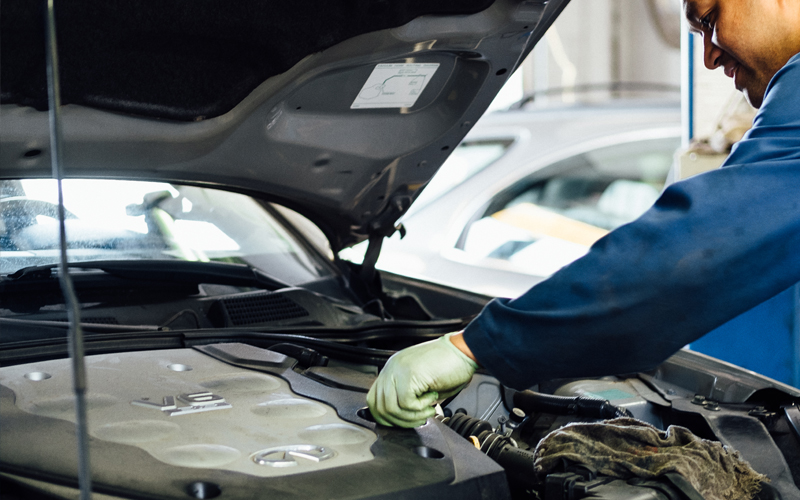
Cooling System Repair
The importance of regular cooling system maintenance
Regular cooling system maintenance is important because your vehicle’s cooling system protects your engine from the severe damage that can be triggered by overheating. The cooling system provides thermal protection through a coolant fluid made of a water and antifreeze blend. As your vehicle runs and produces heat, the coolant fluid circulates through your radiator and engine, thereby lowering its temperatures and protecting the mechanical components from damage. A leak in the cooling system can rapidly deplete your coolant fluid levels and put your vehicle in imminent danger of overheating and system damage. Regular inspections, top-offs of fluids, and periodic coolant flushes ensure that your cooling system operates efficiently and protects your vehicle from harm.
How to check your coolant levels
Vehicle owners should check their coolant levels regularly and before any long trips, just as you do your oil. Your coolant reservoir is a thick white plastic container found under the hood of your vehicle. The semi-translucent reservoir contains a brightly colored fluid (available in nearly every color of the rainbow depending on formulation). It is usually topped with a colored lid. There is no need for a dipstick check like you do with engine oil. Coolant levels can simply be checked visually by comparing the actual fluid level to the minimum and maximum markings on the side of the reservoir. If fluid levels are low, you can add fluid yourself, but be sure to monitor the levels more frequently as you may have developed a system leak. Also, check the fluid color to confirm it is still bright and clear, not cloudy and muddy. It is best to check your coolant levels before running your vehicle. If you need to add any coolant to the reservoir, it can only be done while the engine is cool. It is dangerous to unscrew the reservoir cap when the engine has been running because the cooling system is pressurized and could spray hot fluids on you when you crack the cap.
How often to get cooling system maintenance
In addition to regular self-checks of the coolant levels and color, you should also bring your vehicle in for professional cooling system maintenance. Scheduled maintenance recommendations vary by vehicle and type of coolant used, so check the manufacturer guidelines for specifics on your car. In general, most vehicles are due for a full inspection every 48,000 – 96,000 kilometers (30,000-60,000 miles) or every 3 to 5 years. However, some coolants are formulated to last even longer.
Types of Engine Coolant
Your automobile manufacturer will recommend the best type of engine coolant for your vehicle. There are three basic types of coolants available: IAT, OAT, and HOAT.
Inorganic Additive Technology (IAT)
This type of coolant has a distinctive green color and is most often found in older vehicles rather than modern cars. The IAT fluid is very anti-corrosive but becomes acidic over time, so it needs to be flushed and changed every two years or 38,000 kilometers (24,000 miles).
Organic Acid Technology (OAT)
Most General Motors vehicles run with OAT coolant, although it is used by several other manufacturers as well. This coolant type comes in yellow, orange, red, or purple coloring. It uses special additives to extend its lifespan, so an OAT coolant typically lasts for five years or 80,000 kilometers (50,000 miles) before needing a flush.
Hybrid Organic Acid Technology (HOAT)
Many Crysler and Ford vehicles use a hybrid organic acid technology (HOAT) coolant fluid. HOAT fluids come in orange or yellow colors and offer the benefits of both IAT and OAT technologies with corrosion defense and a longer lifespan. The lifespan of HOAT coolant is similar to that of OAT.
How to tell if your vehicle needs cooling system maintenance or repair
While your vehicle will need cooling system checks at standard intervals, you may also encounter issues that require more urgent attention and repair. If you notice any of the following problems during your self-inspections or while operating the vehicle, call us to schedule a cooling system inspection and repair:
- Continuously low coolant levels, even after topping off
- Coolant fluid leaking from under vehicle
- Coolant light illuminated on the dash
- Engine temperature gauge reading higher or lower than normal
- Vehicle’s heater not working properly
- Sweet smell
- Poor gas mileage
- Rough idle
How long it takes for cooling system maintenance
As you plan your regular cooling system maintenance, expect the work on your vehicle to take an average of 30 to 60 minutes to complete. The total time will vary depending on your vehicle's make and model and any issues that may be found during an inspection.
What is included in cooling system maintenance?
When you bring your vehicle to us for cooling system maintenance, we will first do a visual inspection to
ensure all cooling system components are intact. This includes hoses and belts. We will check the radiator for
leaks, corrosion, clogged fins, and damaged tubes. The head gasket will also be inspected, as a faulty head
gasket leaves oily deposits inside the fill neck of your radiator.
Once our inspections are complete, we will perform a radiator pressure cap test, engine cooling fan test,
thermostat check, pressure test to identify external leaks, and internal leak test. If your coolant needs to
be replenished or flushed, and filled, we will take care of that as well during your maintenance appointment.
Your vehicle will leave our shop running nice and smooth with the cooling system operating at peak efficiency.